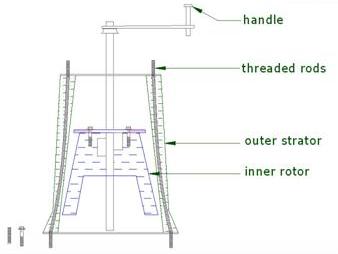Anonymous1 (talk | contribs) No edit summary |
No edit summary |
||
| Line 1: | Line 1: | ||
{{TOCright}} | {{TOCright}} | ||
== Abstract == | == Abstract == | ||
<center>''To improve the Universal nut sheller, the LC Sheller design lowered the cost and weight of existing design using locally available and light weight materials. ''</center> | <center>''To improve the Universal nut sheller, the LC Sheller design lowered the cost and weight of existing design using locally available and light weight materials. ''</center> | ||
| Line 18: | Line 19: | ||
== Costs == | == Costs == | ||
The | The costs, in both dollars and hours, required to build an LC sheller are estimated to be: | ||
=== Materials === | === Materials === | ||
{| class="wikitable" | {| class="wikitable" | ||
| Line 53: | Line 54: | ||
| | | | ||
| 46.00 | | 46.00 | ||
|} | |||
===Time=== | |||
{| class="wikitable" | |||
|- | |||
! Project Step | |||
! Approximate Time Required | |||
|- | |||
| Mold Assembly, mixing and pouring | |||
| 2 hours | |||
|- | |||
| Roughing the inner surfaces (24 hours later) | |||
| 20 minutes | |||
|- | |||
| Form assembly | |||
| 1 hour | |||
|- | |||
| Total time | |||
| 3-4 hours | |||
|} | |} | ||
== Specifications == | == Specifications == | ||
Technical specifications including a schematic (CAD, pictures of the device). | Technical specifications including a schematic (CAD, pictures of the device). | ||
[[Image: | [[Image:Cad.jpg]] | ||
== Construction instructions == | == Construction instructions == | ||
Revision as of 02:24, 12 December 2008
Abstract
Keywords: Full Belly Project, Sheller, lightweight concrete
Background
The Full belly Project is an organization which creates low cost, simple technological solutions to be implemented in developing countries. One of these solutions, the Universal Nut Sheller, minimizes the work load of women in Western Africa by allowing nuts to be shelled through this device rather than by hand.
Problem Statement and Criteria
Currently in West Africa, the nut sheller that are in use, weighing some ninety pounds are placed on the back of bicycles and transported long distances. This presents serious drawbacks in terms of trasnportability and raises the risk of breakage. Additionally, the cement in West Africa is costly and of poor quality. For these reasons, the Full Belly Project's executive director helped Team Nuts for Peace come up with the following criteria:
- Cost
- To reduce the cost of the Universal Nut Sheller
- Transportability
- To improve the transportability
- Durability
- To maintain or increase the durability of the UNS
- Safety
- The degree of safety required for the final product
- Ease of Construction
- To minimize the number of specialists in the implementation process
Costs
The costs, in both dollars and hours, required to build an LC sheller are estimated to be:
Materials
| Product | Quantity | Price ($) |
|---|---|---|
| Cement | 1 bag (94 lb) | 15.00 |
| sand | 1 bag (60 lb) | 12.00 |
| clay (dry) | 2 gallons | harvested |
| Machine Grease | 1 can | 4.00 |
| Threaded Rod | 1 | 15.00 |
| UNS Mold | 1 | provided by Full Belly Project |
| Total costs | 46.00 |
Time
| Project Step | Approximate Time Required |
|---|---|
| Mold Assembly, mixing and pouring | 2 hours |
| Roughing the inner surfaces (24 hours later) | 20 minutes |
| Form assembly | 1 hour |
| Total time | 3-4 hours |
Specifications
Technical specifications including a schematic (CAD, pictures of the device).

Construction instructions
Equal mix (by volume) of cement, sand, clay and sawdust. Use fine grained clay, obtained by running dry, crushed clay through a sieve or screen. Also use fine sawdust, as opposed to wood shavings. Mix material dry, then slowly add water while mixing until desired consistency is obtained. This should be enough water for all materials (especially cement) to be wet, but is not too hard to mix. A slightly less-than cottage cheese wetness is acceptable. Follow Full Belly instructions as normal. Instructions http://www.fullbellyproject.org/Documents/UNS.pdf
Next steps
While improvements were made to the UNS, additional materials testing could result in a mixture that more thoroughly meets the Fully Belly Project's criteria. The final mixture decided upon is a base to move from.